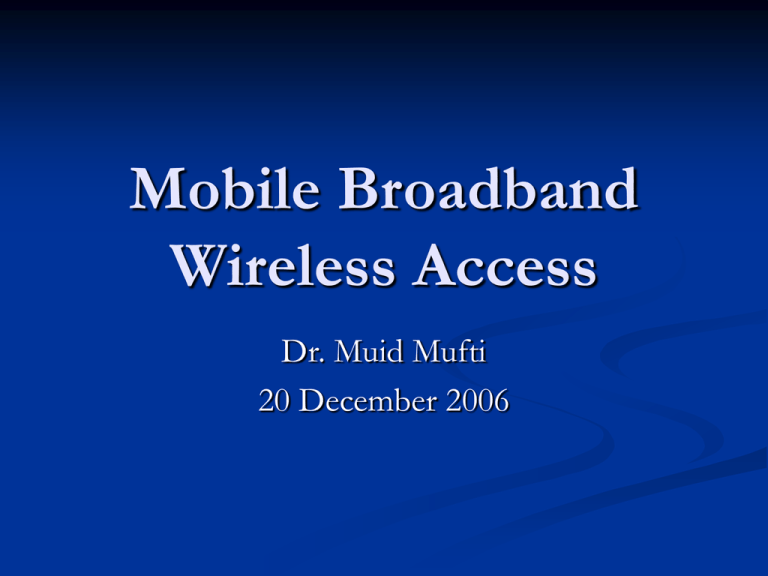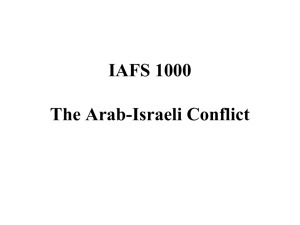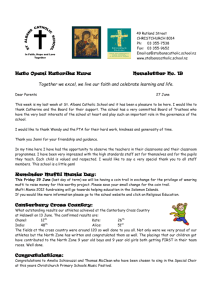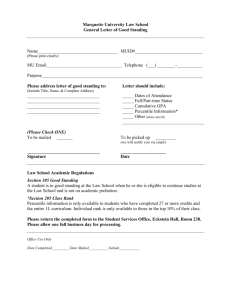Mobile Broadband Wireless Access
advertisement

Mobile Broadband Wireless Access Dr. Muid Mufti 20 December 2006 History of Wireless First Ever Wireless Communication ? First Mobile Radio Telephone 1924 Phenomenal growth with the turn of the century Dr. Muid Mufti Telematix The Wireless Experience Global Satellite Suburban Macrocell Urban Microcell In-Building Picocell Basic Terminal PDA Terminal Audio/Visual Terminal Dr. Muid Mufti Telematix Advantages of Wireless Low cost Low maintenance Quick deployment Reduced sunk cost Mobility Dr. Muid Mufti Telematix Disadvantages of Wireless Non secure Environmentally vulnerable Frequency reuse issues Dr. Muid Mufti Telematix Ubiquitous Networks MBWA based product MBWA based Services Cell phone TV Streaming Multimedia Video on Demand Mobile medical aid Train entertainment systems Surveillance Strategic MBWA business Dr. Muid Mufti Telematix Defining Broadband High dates rates ? FCC definition of broadband: Connections with speed exceeding 200 Kb/s in at least one direction PTA definition of broadband: High speed, ‘always on’ Internet connection. Speed of connection ranging from 128 Kbps to 2 Mbps or higher. Refers to the ability of the user to view content across the internet that includes large files, such as video, audio, multimedia and 3D graphics QoS Support Dr. Muid Mufti Telematix Mobile vs. Wireless Wireless Dr. Muid Mufti Mobile Telematix Mobility Range of mobility Geographic range Across networks IP mobility Speed of mobility Personal mobility Vehicular mobility Frequency of mobility Mobility Overhead Dr. Muid Mufti Telematix MBWA Be able to support broadband data rates with given QoS with mobility Mobility speed Personal mobility 100+ km/h – high speed trains, cars, buses etc. Dr. Muid Mufti Telematix QoS – Conversational / Real-time Services Medium Application Data rate Key Performance parameters and target values One-way Delay Delay Variation Information Loss <1 msec <3% FER Audio Conversational voice 4–13 kbps <150 msec Preferred <100 msec Video Videophone 32–384 kbps <150 msec Data Telemetry twoway control <28.8 kbps <250 msec N.A. Zero Data Interactive games <1 KB <250 msec N.A. Zero Data Telnet <1KB <250 msec N.A. Zero Dr. Muid Mufti <1% FER Telematix QoS - Interactive Services Medium Application Data rate One-way Delay Delay Variation Information Loss <1 sec Playback <2 sec record <1 msec <3% FER Audio Voice messaging Data Web-browsing HTML <4 sec/page N.A. Zero Data Transactions Services High Priority ecommerce, ATM <250 msec N.A. Zero Data Interactive games <250 msec N.A. Zero Dr. Muid Mufti 4–13 kbps Key Performance parameters and target values Telematix QoS - Streaming Services Medium Application Data rate Key Performance parameters and target values One-way Delay Delay Variation Information Loss <1 msec <1% FER Audio High quality Streaming audio 32–128 kbps <10 sec Video One-way 32–384 kbps <10 sec Data Bulk data Transfer/retrieval <10 sec N.A. Zero Data Still image <10 sec N.A. Zero Data Telemetry monitoring <10 sec N.A. Zero Dr. Muid Mufti <28.8 kbps <1% FER Telematix Mobile Broadband Development Streams UMTS-TDD (WCDMA-TDD) FDD W-CDMA TD-SCDMA 1x EVDO WiMAX (802.16e) 802.20 (MobileFi) Dr. Muid Mufti Telematix Global Wireless Data Standards WUSB Data Rates 802.15 Zigbee 802.16 WiMax 802.11 Wifi 802.20 MobileFi Bluetooth UMTS GPRS Range Dr. Muid Mufti Telematix Global Wireless Data Standards Network Coverage Data Rates Mobility Cost Satellite (B-GAN) World Max. 144 Kb/s High High GSM/GPRS Aprox. 35 KM 9.6 Kb/s up to 144 Kb/s High High IEEE 802. 16a Aprox. 30 KM Max. 70 Mb/s Low/Medium Medium IEEE 802. 20 Aprox. 20 KM 1-9 Mb/s Very High High UMTS 20 KM Up to 2 Mb/s High High HIPERLAN 2 70 up to 300 m 25 Mb/s Medium/high Low IEEE 802.11a 50 up to 300 m 54 Mb/s Medium/high Low IEEE 802.11b 50 up to 300 m 11 Mb/s Medium/high Low Bluetooth 10 m Max. 700 Kb/s Very low Low Dr. Muid Mufti Telematix Basic Modulation Schemes Dr. Muid Mufti Telematix UMTS-TDD Up to 12Mbps More than 3 times higher than any other commercial mobile platform. True N=1 frequency reuse Network operator can deploy a network with multiple towers using only one RF Channel 5 MHz RF channel for a 3.84 Mcps system 10 MHz channel for a 7.68 Mcps system. Mobility up to 120 km/hr within the network footprint Tower-to-tower handoff roaming Network-to-network roaming Dr. Muid Mufti Telematix FDD W-CDMA Frequency band:1920 MHz -1980 MHz and 2110 MHz - 2170 MHz (Frequency Division Duplex) Minimum frequency band required: ~ 2x5MHz Frequency re-use: 1 Carrier Spacing: 4.4MHz - 5.2 MHz Maximum number of (voice) channels on 2x5MHz: ~196 (spreading factor 256 UL, AMR 7.95kbps) / ~98 (spreading factor 128 UL, AMR 12.2kbps) Voice coding: AMR codecs (4.75 kHz - 12.2 kHz, GSM EFR=12.2 kHz) and SID (1.8 kHz) Channel coding: Convolutional coding, Turbo code for high rate data Duplexer needed (190MHz separation), Asymmetric connection supported Tx/Rx isolation: MS: 55dB, BS: 80dB Receiver: Rake Receiver sensitivity: Node B: -121dBm, Mobile -117dBm at BER of 10-3 Data type: Packet and circuit switch Modulation: QPSK Pulse shaping: Root raised cosine, roll-off = 0.22 Chip rate: 3.84 Mcps Dr. Muid Mufti Telematix FDD W-CDMA Channel raster: 200 kHz Maximum user data rate (Offered): 384 kbps (year 2002), higher rates ( ~ 2 Mbps) in the near future. HSPDA will offer data speeds up to 8-10 Mbps (and 20 Mbps for MIMO systems) Channel bit rate: 5.76Mbps Frame length: 10ms (38400 chips) Number of slots / frame: 15 Number of chips / slot: 2560 chips Handovers: Soft, Softer, (interfrequency: Hard) Power control period: Time slot = 1500 Hz rate Power control step size: 0.5, 1, 1.5 and 2 dB (Variable) Power control range: UL 80dB, DL 30dB Mobile peak power: Power class 1: +33 dBm (+1dB/-3dB) = 2W; class 2 +27 dBm, class 3 +24 dBm, class 4 +21 dBm Number of unique base station identification codes: 512 / frequency Dr. Muid Mufti Telematix TD-SCDMA China Wireless Telecommunication Standards group (CWTS) Approved by the ITU in 1999 Developed by the Chinese Academy of Telecommunications Technology and Siemens Frequency band: 2010 MHz - 2025 MHz in China (WLL 1900 MHz - 1920 MHz) Minimum frequency band required: 1.6MHz Frequency re-use: 1 (or 3) Chip rate: 1.28 Mcps Frame length: 10ms Number of slots: 7 Modulation: QPSK or 8-PSK Dr. Muid Mufti Telematix TD-SCDMA Voice data rate: 8kbit/s Circuit switched services: 12.2 kbits/s, 64 kbits/s, 144 kbits/s, 384 kbits/s, 2048 kbits/s Packet data: 9.6kbits/s, 64kbits/s, 144kbits/s, 384kbits/s, 2048kbits/s Receiver: Joint Detection, (mobile: Rake) Power control period: 200 Hz Number of slots / frame: 7 Frame length: 5ms Multi carrier option Handovers: Hard Uplink synchronization Dr. Muid Mufti Telematix 1x EVDO (CDMA 2000) Qualcomm USA. Frequency band: Any existing band. Minimum frequency band required: 1x: 2x1.25MHz, 3x: 2x3.75 Chip rate: 1x: 1.2288, 3x: 3.6864 Mcps Maximum user data rate: 1x: 144 kbps now, 307 kbps in the future 1xEV-DO: max 384 kbps - 2.4 Mbps, 1xEVDV: 4.8 Mbps. Frame length: 5ms, 10ms or 20ms Power control rate: 800 Hz Spreading factors: 4 ... 256 UL Dr. Muid Mufti Telematix Migration to 3G 3G 2.75G Intermediate Multimedia 2.5G Multimedia Packet Data 2G Digital Voice 1G Analog Voice GPRS GSM EDGE W-CDMA (UMTS) 384 Kbps Up to 2 Mbps 115 Kbps NMT 9.6 Kbps GSM/ GPRS TD-SCDMA (Overlay) 115 Kbps 2 Mbps? TDMA TACS 9.6 Kbps iDEN 9.6 Kbps iDEN PDC (Overlay) 9.6 Kbps AMPS CDMA 1xRTT CDMA 14.4 Kbps / 64 Kbps PHS 1984 - 1996+ Dr. Muid Mufti 1992 - 2000+ cdma2000 1X-EV-DV PHS (IP-Based) 144 Kbps 64 Kbps 2001+ 2003+ Over 2.4 Mbps 2003 - 2004+ Source: U.S. Bancorp Piper Jaffray Telematix IEEE 802.16e 802.16e Mobile WirelessMAN Approved by IEEE Feb 2006 NLOS with Antenna Diversity FDD / TDD Multiple Convergence layers IP Ethernet ATM Dr. Muid Mufti Telematix Adaptive PHY Dr. Muid Mufti Burst-by-burst adaptivity not shown Telematix WIMAX-802.16-2004 Access Scheme OFDM/Time Division Multiple Access (TDMA), Orthogonal Frequency Division Multiple Access (OFDMA) Duplexing1 TDD, FDD Channelisation2 (802.16-2004) Between 1.25 to 28MHz Throughput (802.16-2004 std) Depends on individual vendor. Up to 134Mbps for SC at 28MHz Throughput varies with modulation scheme and channel bandwidth (i.e. For 20 MHz of channelisation, throughput is 32Mbps using QPSK, throughput is 64Mbps using 16QAM). Available Customer Devices Mainly fixed certified equipment expected to be available in 2005/2006. Currently, most available products are pre-WIMAX. Limited mobility (802.16e) likely mid/end 2006. Mobility Fixed and nomadic without handoff (802.16-2004) at this point. Limited and full mobility (802.16e) up to 100 km/h in mid/end 2006. Spectrum3 2-11 GHz, 10-66 GHz (Main focus: 2.5 GHz, 3.5 GHz and unlicensed 5.8 GHz) Dr. Muid Mufti Telematix Adaptive Burst Profiles Burst profile Dynamically assigned according to link conditions Modulation and FEC Burst by burst, per subscriber station Trade-off capacity vs. robustness in real time Roughly doubled capacity for the same cell area Burst profile for downlink broadcast channel is well-known All other burst profiles could be configured “on the fly” Subscriber station capabilities recognized at registration Dr. Muid Mufti Telematix Duplex Scheme Support On downlink , SS is associated with a specific burst On uplink , SS is allotted a variable length time slot for their transmissions Time-Division Duplex (TDD) Downlink & Uplink time share the same RF channel Dynamic asymmetry SS does not transmit & receive simultaneously (low cost) Frequency-Division Duplex (FDD) Downlink & Uplink on separate RF channels Static asymmetry Half-duplex SSs supported Dr. Muid Mufti SS does not transmit & receive simultaneously (low cost) Telematix Duplex Scheme Support On downlink , SS is associated with a specific burst On uplink , SS is allotted a variable length time slot for their transmissions Time-Division Duplex (TDD) Downlink & Uplink time share the same RF channel Dynamic asymmetry SS does not transmit & receive simultaneously (low cost) Frequency-Division Duplex (FDD) Downlink & Uplink on separate RF channels Static asymmetry Half-duplex SSs supported Dr. Muid Mufti SS does not transmit & receive simultaneously (low cost) Telematix TDD Frame (10-66 GHz) n PS = (Symbol Rate x Frame Length) / 4 Downlink Subframe Adaptive PS 0 Frame j-2 Dr. Muid Mufti Uplink Subframe Frame j - 1 Frame j PS n-1 Frame j+1 Frame j+1 Telematix TDD Downlink Subframe Preamble TDM Portion Broadcast Control DUIC = 0 TDM DUIC a TDM DUIC b TDM DUIC c Preamble Tx/Rx Transition Gap Dr. Muid Mufti DL- MAP UL-MAP DIUC: Downlink Interval Usage Code Telematix Burst FDD Framing DOWNLINK UPLINK Frame Broadcast Half Duplex Terminal #1 Full Duplex Capable User Half Duplex Terminal #2 Allows scheduling flexibility Dr. Muid Mufti Telematix FDD Downlink Subframe TDM DIUC c TDM DIUC d TDMA Portion TDM DIUC e TDM DIUC f Preamble TDM DIUC b Preamble TDM DIUC a Preamble Broadcast Control DUIC = 0 Preamble Preamble TDM Portion TDM DIUC g Preamble Burst Start Points DL-MAP Dr. Muid Mufti UL-MAP Telematix Fragmentation Partitioning a MAC SDU into fragments transported in multiple MAC PDUs Each connection can be in only a single fragmentation state at any time Contents of the fragmentation sub-header: 2-bit Fragmentation Control (FC) Unfragmented, Last fragment, First fragment, Continuing fragment 3-bit Fragmentation Sequence Number (FSN) Dr. Muid Mufti required to detect missing continuing fragments continuous counter across SDUs Telematix Packing The process of combining multiple MAC SDUs (or fragments thereof) into a single MAC PDU On connections with variable length MAC SDUs On connections with fixed length MAC SDUs Packed PDU contains a sub-header for each packed SDU (or fragment thereof) No packing sub-header needed Packing and fragmentation can be combined Can, in certain situations, save up to 10% of system bandwidth Dr. Muid Mufti Telematix Classes of Service Characteristic of the Service Flow Unsolicited Grant Services (UGS) Real-time Polling Services (rtPS) for rt -VBR-like SFs such as MPEG video Non-real-time Polling Services (nrtPS) for constant bit-rate (CBR) or CBR-like service flows (SFs) such as T1/E1 for nrt SFs with better than best effort service such as bandwidthintensive file transfer Best Effort (BE) for best-effort traffic Dr. Muid Mufti Telematix UGS No explicit bandwidth requests issued by SS Prohibited from using any contention requests No unicast request opportunity provided May include a Grant Management (GM) sub-containing header containing Slip indicator: indicates that there is an backlog in the buffer due to clock skew or loss of maps Poll-me bit: indicates that the terminal needs to be polled (allows for not polling terminals with UGS-only services). Dr. Muid Mufti Telematix RTPS Intended for rt-VBR-like service flows such as MPEG video Prohibited from using any contention requests Terminals polled frequently enough to meet the delay requirements of the SFs Bandwidth requested with BW request messages (a special MAC PDU header) May use Grant Management sub-header new request can be piggybacked with each transmitted PDU Dr. Muid Mufti Telematix NRTPS Intended for non-real-time service flows with better than best effort service e.g. bandwidth-intensive file transfer Works like rt-polling except that polls are issued less frequently Allowed to use contention requests May use Grant Management sub-header new request can be piggybacked with each transmitted PDU Dr. Muid Mufti Telematix BE Generic data e.g. HTTP, SMTP, etc. No QoS guarantees Allowed to use contention requests May use Grant Management sub-header new request can be piggybacked with each transmitted PDU Dr. Muid Mufti Telematix Request/Grant Scheme Self Correcting No acknowledgement All errors are handled in the same way, i.e., periodical aggregate requests Bandwidth Requests are always per Connection Grants are either per Connection (GPC) or per Subscriber Station (GPSS) Grants (given as durations) are carried in the UL-MAP messages SS needs to convert the time to amount of data using information about the UIUC Dr. Muid Mufti Telematix WIMAX Deployment Aperto 2.5 GHz, 3.3 GHz , 3.5 GHz, 5.3GHz , 5.8 GHz Deployed/trialed by: Iberbanda, Spain; Enertel, Holland; Sequelle Communications Alliance, USA Dr. Muid Mufti Telematix Alvarion 3.5 GHz, 5.8 GHz, 2.5 GHz Summerside Community Network, USA Telekom Serbia, Israel Axtel, Mexico Dr. Muid Mufti Telematix Nex-G Target licensed exempt bands initially e.g. 5.8 GHz. Subsequently licensed bands e.g. 3.5 Ghz, 2.5 Ghz Dr. Muid Mufti Telematix Redline Communications 3.5 GHz, 5.4 GHz, 5.8 GHz Telabria, UK I-Netlink Wireless, Canada; Thirteen WNET/New York, USA Dr. Muid Mufti Telematix WiLAN 2.4 GHz, 3.5 GHz, 5.8GHz Marathon Oil, USA TM Net Sdn. Bhd, Malaysia Dr. Muid Mufti Telematix IEEE 802.20 802.20 (Mobile Fi) Mobile Broadband Wireless Access (MBWA) Below 3.5 GHz bands Optimized for IP-data transport Peak data rates per user in excess of 1 Mbps supports various vehicular mobility classes up to 250 Km/h Range up to 20 Km Extremely low latency at 20 milliseconds or less Dr. Muid Mufti Telematix 802.20 (Mobile Fi) The 802.20 interface seeks to boost real-time data transmission rates in wireless metropolitan area networks to speeds that rival DSL and cable connections Cell sizes to commensurate with ubiquitous metropolitan Targets spectral efficiencies, sustained user data rates Numbers of active users significantly higher than achieved by existing mobile systems Dr. Muid Mufti Telematix 802.20 (Mobile Fi) Efficient packet-based air interface with highspeed downlink and uplink capabilities It will enable telephony using Voice over Internet Protocol (VoIP) and activities needing rapid network response times, such as online gaming and financial transactions The standard also will support other IP-centric applications, so the many native IP applications can be used without alteration. Dr. Muid Mufti Telematix Spectral Efficiencies Dr. Muid Mufti Telematix Design Criteria Broad Market Potential Compatibility Broad sets of applicability. Multiple vendors and numerous users. Balanced costs Conformance with 802 Overview and Architecture Conformance with 802.1D (MAC Bridges) and 802.1F (VLAN Bridges) Conformance with 802.1F and compatible managed object definitions Identification of any variance in conformance Coexistence. Dr. Muid Mufti Telematix Design Criteria Distinct Identity Technical Feasibility Substantially different from other IEEE 802 standards. One unique solution per problem. Easy for the document reader to select the relevant specification. Demonstrated system feasibility. Proven technology, reasonable testing. Confidence in reliability. Economic Feasibility Known cost factors, reliable data. Reasonable cost for performance. Consideration of installation costs Dr. Muid Mufti Telematix 802.20 vs. 802.16e 802.16e - 2 to 6 GHz licensed bands, while 802.20 below 3.5GHz. 802.16e - based on an existing standard (802.16a), while 802.20 is starting from scratch. 802.16e – approved by IEEE February 2006, while 802.20 is under development. 802.16e - 120 to 150 kilometers per hour , while 802.20 up to 250 kilometers per hour 802.16e - mobile user walking around with a PDA or laptop, while 802.20 will address high-speed mobility issues 80216e – deployment in their existing [.16a] footprint, while 802.20 is looking at more ubiquitous coverage. Fate of both standards rests with 802.16 - if there's success in the 802.16 market, it will portend good things for the 802.20 Dr. Muid Mufti Telematix MBWA Deployment ArrayComm System 1 Mbps/345 kbps (5 MHz bandwidth) Dr. Muid Mufti < 80 kmph Standard affiliation PCMCIA, Standalone Ethernet USB modem Mobility 5 or 10 MHz TDD Per User Throughout (DL/UL) Available Customer Devices TDMA/FDMA/SDMA Spectrum iBurst Access Scheme 802.20 Commercialization PBA, Australia; WBS, South Africa,8 ongoing trials Telematix Flarion System Access Scheme Flash OFDM, Flash-OFDM Flexband Spectrum Available Customer Devices RadioRouter 2x 1.25 MHz FDD, 2 x 5Mhz FDD (three 1.25Mhz carriers), 2 x 5Mhz FDD (one 5Mhz carrier) Per User Throughout (DL/UL) 1.5Mbps/500kbps, 2.5Mbps/900kbps, 6.0Mbps/2.5Mbps Dr. Muid Mufti Mobility < 300 kmph Standard affiliation PCMCIA Desktop modem Chipset WiFi/FOFDM AP 802.20 Commercialization Nextel, North Carolina, US; CellularOne, Texas, US; Vodafone, Japan; Telstra, Australia; T-Mobile, Netherlands; OCTO (Public Safety), Washington DC, US. Telematix IPWirless System UMTS TD-CDMA 5 or 10 MHz TDD 2x 5 MHz FDD 2x 10MHz FDD Per User Throughout (DL/UL) 1.5 Mbps/512 kbps (5 MHz bandwidth) Available Customer Devices Spectrum IPWireless Access Scheme Mobility 3GPP UMTS TDD Commercialisation Dr. Muid Mufti < 120 kmph Standardisation affiliation PCMCIA Standalone Ethernet USB modem Chipset IPWireless/WiFi gateway VoIP Integrated Access Device Woosh Wireless, NZ; UK Broadband (PCCW); Maxis, Malaysia; Sentech, South Africa; AirData, Germany 15 ongoing trials: Telematix Samsung System OFDMA 10 MHz TDD Per User Throughout (DL/UL) 3 Mbps/1 Mbps Dr. Muid Mufti Available Customer Device Spectrum WIMAX/Wibro Access Scheme Mobility < 120 kmph Standard affiliation PCMCIA WIMAX 802.16e Commercialization None yet. Telematix Navini System Access Scheme MC-SCDMA Spectrum Available Customer Devices Ripwave 5 MHz TDD Per User Throughout (DL/UL) 2.0 Mbps/1.0 Mbps (max.) for standalone and outdoor modem. 1.0 Mbps/.5 Mbps (max.) for PCMCIA Mobility 802.20 802.16e Commercialization Dr. Muid Mufti Limited low speed mobility until WIMAX 802.16e Standard affiliation PCMCIA Standalone Ethernet/USB modem Outdoor Modem IBAX, Italy; Unwired, Australia; 11 ongoing trials. Telematix References http://grouper.ieee.org/groups/802/20/ http://www.iad.gov.pk IEEE 802.16 specs Dr. Muid Mufti Telematix Questions



